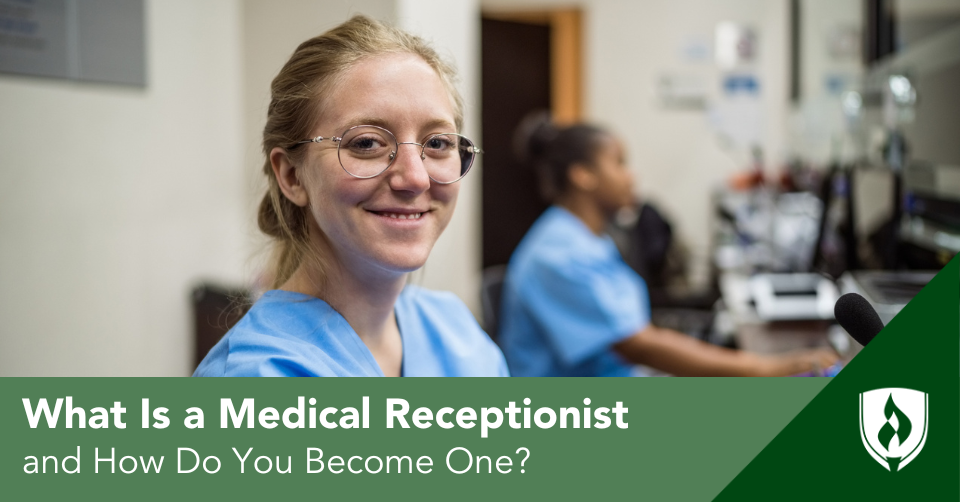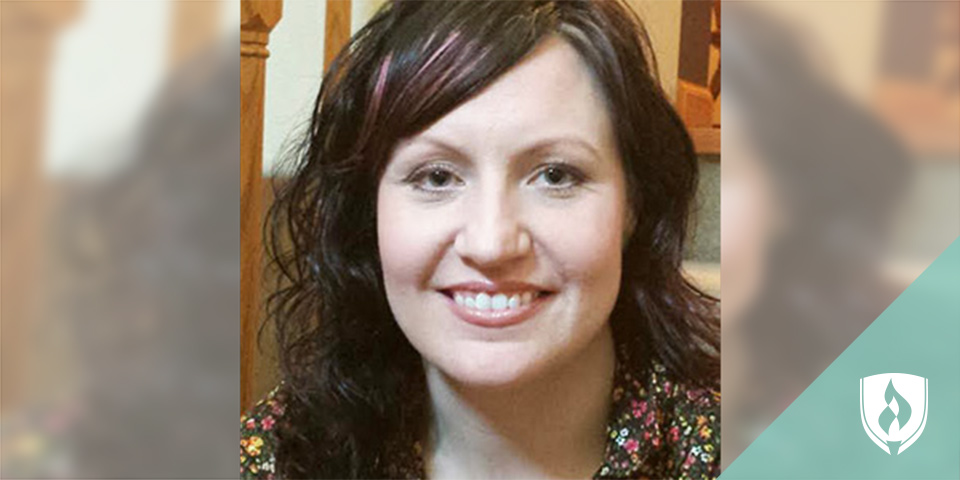
At some point in our lives, we all come into the doctor’s office. Whether it’s for an annual screening, a quick flu shot or with a screaming baby struggling with an ear infection, the first person you interact with when you walk through the clinic doors is a medical receptionist.
Though the circumstances surrounding a visit to a clinic can be downright miserable for some patients, being greeted by a kind and knowledgeable medical receptionist can go a long way toward making the visit a positive experience.
You probably didn’t give this role a second thought while you were in the middle of your last sinus infection, but it’s worth reconsidering. The career of a medical receptionist offers a stable and interesting path into the healthcare industry. Plus, with the United States’ large baby boomer population aging, demand for healthcare services and the professionals providing them will remain strong, according to the Bureau of Labor Statistics (BLS).1
If you are looking for opportunities within a stable field, becoming a medical receptionist could be a great fit for your career. In this article we’ll take a closer look at the role as well as how to become a medical receptionist.
What is a medical receptionist?
Medical receptionists—sometimes called medical administrative assistants, unit secretaries or patient coordinators—are administrative professionals within a healthcare setting. These are the people you interact with when you schedule an appointment, make billing inquires or come into a hospital, clinic or laboratory for an appointment.
Unlike a receptionist in a traditional office, medical receptionists have extensive knowledge of medical terminology and healthcare procedures. They are responsible for an essential link between the healthcare infrastructure, providers and the people seeking medical care.
Where do medical receptionists work?
Medical receptionists work in pretty much any patient-facing medical facility or medical office. They staff community clinics, hospitals, laboratories, private practices and any other medical settings where you might come in for care.
According to the BLS medical receptionists are most often employed in physician's offices, followed by general medical and surgical hospitals and then dentist’s offices.1 This wide variety of options means medical receptionists can choose to work in fast-paced locations such as emergency care, or quieter locations such as nursing homes or outpatient clinics offering treatment in anything from behavioral health to physical therapy.
As a medical receptionist or administrative assistant, you have the opportunity to find jobs across a diverse variety of workplace settings and work with a wide range of health care practitioners in order to find the best fit for your needs and interests.
What do medical receptionists do?
Though medical receptionists work in many unique environments and medical facilities, the majority of a medical receptionist’s work responsibilities are consistent across the profession.
What are some common medical receptionist duties?
According to the U.S. Department of Labor, medical receptionists are typically responsible for the following:2
- Answering phones and directing calls to appropriate staff.
- Scheduling and confirming patient diagnostic appointments, surgeries or medical consultations.
- Operating the equipment in doctor's offices such as voice mail messaging systems, word processing, spreadsheets or other software applications to prepare reports, invoices, financial statements, letters, case histories or patient records.
- Maintaining medical records, technical libraries or correspondence files.
- Greeting visitors, discovering the purpose of their visit and directing them to appropriate staff.
A significant portion of a medical receptionist’s job involves working with others. They make it possible for patients to find the care they need, make correct records available to healthcare providers, perform various administrative tasks and create a safe and warm atmosphere in what can be intimidating medical environments. If you’re a natural at making people feel welcome, you’re already off to a great start.
How do you become a medical receptionist?
While some aspects of this job may come naturally to you, there are also role-specific skills you’ll want to refine. Let’s take a closer look at several of the sought-after technical and transferable skills of an effective medical receptionist or medical assistant.
What technical skills do you need to become a medical receptionist?
To be a medical receptionist requires strong interpersonal skills, technical knowledge and critical attention to detail. These skills can be gained in an educational setting or in on-the-job training.
According to our analysis of over 146,000 medical receptionist job postings, these are the most in-demand medical receptionist skills:3
- Administrative support
- Scheduling appointments
- Appointment setting
- Customer service
- Customer billing
- Medical terminology
- Patient data entry
- Electronic medical records
- Clerical duties
- Health Insurance Portability and Accountability Act (HIPAA)
Though many of these necessary skills can be learned in advance of becoming a medical receptionist, some are better learned in a medical setting. You'll learn a bunch of skills on the job—especially when it comes to navigating specific technical skills, medical software and patient accounts.
What soft skills do you need to become a medical receptionist?
There are also some broader traits, qualities and transferrable skills that can be particularly useful across medical assistant professions. Here are five important qualities for people interested in becoming medical receptionists:
- Strong communication skills: Medical receptionists communicate complex information about billing and scheduling with patients. Strong communication skills like etiquette during phone calls and cultural competency are essential for helping all patients navigate their medical needs.
- Ability to multi-task: As a medical receptionist you may be juggling writing an email with checking in a patient for an appointment, all while the telephone rings. A medical receptionist needs the ability to stay cool under the pressure of having many things going on at the same time and know how to prioritize competing demands.
- Attention to detail: As with all administrative work, a keen eye to detail is very important. Particularly when dealing with medical records and the office schedule, being able to spot a small mistake can have very significant consequences.
- Teamwork: The medical receptionist is a key part of a team providing healthcare and support during patient visits. Being able to work closely with other professionals can streamline communication and impact patient experience.
- Positive attitude: The majority of the time people come into a doctor’s office, they are under significant personal stress. Medical receptionists should practice appropriate medical ethics and provide a calm and friendly interaction, improving the experience of both patients and healthcare providers.
What training and education do you need to become a medical receptionist?
Now that you know more about what the job entails, you’re probably wondering what training or education you’ll need to land a medical receptionist role.
Depending on the job market and your geographic location, you may be able to find a job posting you're eligible for with a high school education, but many employers and hiring managers seek applicants with additional training, a college education or a different degree program.
According the U.S. Department of Labor, 48 percent of medical receptionist jobs require a high school diploma or equivalent qualification, and 26 percent require an associate's degree.2 Another 20 percent require a post-secondary certificate to become a medical receptionist—for example a Medical Administrative Assistant Certificate—which can be completed in as few as 9 months.2,4 Certificate programs like this lead toward a career as a certified medical administrative assistant.
Take the first step toward a healthcare career
Now that you know more about what a medical receptionist is, what they’re responsible for and how to become a medical receptionist, is this the right career path for you? If you think it might be, visit the Medical Administrative Assistant Certificate page to learn how Rasmussen College can help provide you with the education and training needed to excel in this critical healthcare job.
Related Articles:
1Bureau of Labor Statistics, U.S. Department of Labor, Occupational Employment Statistics, Occupational Employment and Wages – Medical Secretaries, May 2018 [accessed July, 2023] https://www.bls.gov/oes/current/oes436013.htm Information represents national, averaged data for the occupations listed and includes workers at all levels of education and experience. This data does not represent starting salaries. Employment conditions in your area may vary.
2Bureau of Labor Statistics, U.S. Department of Labor, Occupational Employment Statistics, [accessed July, 2023] www.bls.gov/oes/.
3 Burning-Glass.com (analysis of 146,267 medical receptionist job postings, Oct. 01, 2018 – Sep. 30, 2019).
4Completion time is dependent on number of transfer credits accepted and the number of courses completed each term.



